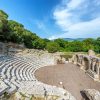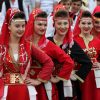Albania may be small, but it is culturally rich boasting a unique artistic and musical heritage shaped by its diverse history, through Illyrian and Ottoman influences to modern European trends. Despite periods of isolation, Albanian culture has thrived, maintaining its distinct identity while adapting to contemporary global movements.
Traditional and Contemporary Art
Albanian art has deep roots in antiquity, with Illyrian and Byzantine influences shaping its early forms. Ancient Illyrian artifacts, including jewellery, pottery, and relief sculptures, showcase the skills of bygone artisans. The medieval period brought stunning Christian iconography, most notably from a 16th-century painter called Onufri, known for his vivid use of red and gold tones in religious frescoes.
During the Ottoman era, Islamic artistic elements, such as intricate calligraphy and mosque decorations, became prominent, blending with local traditions. The 20th century saw socialist realism dominate under Enver Hoxha’s communist regime, where art was used as state propaganda, glorifying workers and revolutionaries. However, since the fall of communism in the 1990s, Albanian artists have embraced modern and abstract art forms, gaining recognition in international galleries. Contemporary artists such as Adrian Paci and Anri Sala have gained global acclaim for their thought-provoking works that explore themes of identity, migration, and history.
Music: From Folk to Modern Genres
Albanian music is deeply tied to its regional diversity, with two major folk traditions: Gheg music in the north and Tosk music in the south. The north is known for epic ballads, often sung with the accompaniment of the lahuta, a one-stringed instrument. These songs recount heroic tales of Albanian warriors and historical events. Southern Albania is famous for Iso-Polyphony, a UNESCO-recognized tradition where multiple voices create haunting harmonies, reflecting the area’s Byzantine and Ottoman musical influences.
Instrumental music is equally diverse, with instruments like the çiftelia (a two-stringed lute), defi (a type of tambourine), and fyelli (a shepherd’s flute) playing a significant role in traditional performances.
In modern times, Albania has embraced contemporary music, producing successful pop, rap, and electronic artists. Singers of Albanian heritage, like Dua Lipa, Rita Ora, and Bebe Rexha, have achieved global fame. Meanwhile, domestic artists such as Elvana Gjata and Noizy have popularized Albanian pop and hip-hop. The country’s participation in Eurovision has further highlighted its musical creativity on an international stage.
Cultural Traditions and Festivals
Albania’s culture is rich with traditions, many rooted in the ancient Kanun, a set of customary laws that emphasize honour, hospitality, and family loyalty. Hospitality is central to Albanian identity, with guests treated with immense respect and generosity.
Major festivals celebrate Albania’s artistic and musical heritage. The Gjirokastër National Folklore Festival, held every five years in the historic town of Gjirokastër, showcases folk music and dance. Other events, such as Tirana International Film Festival and Kala Festival, celebrate cinema and contemporary music, blending Albania’s past with its modern cultural evolution.
Distinctive and unusual culture, well worth discovering
Albania’s art, music, and culture reflect its resilient spirit and diverse influences. From ancient Illyrian relics to modern pop icons, and from haunting polyphonic songs to abstract contemporary art, Albania’s cultural scene continues to evolve while preserving its rich heritage.




